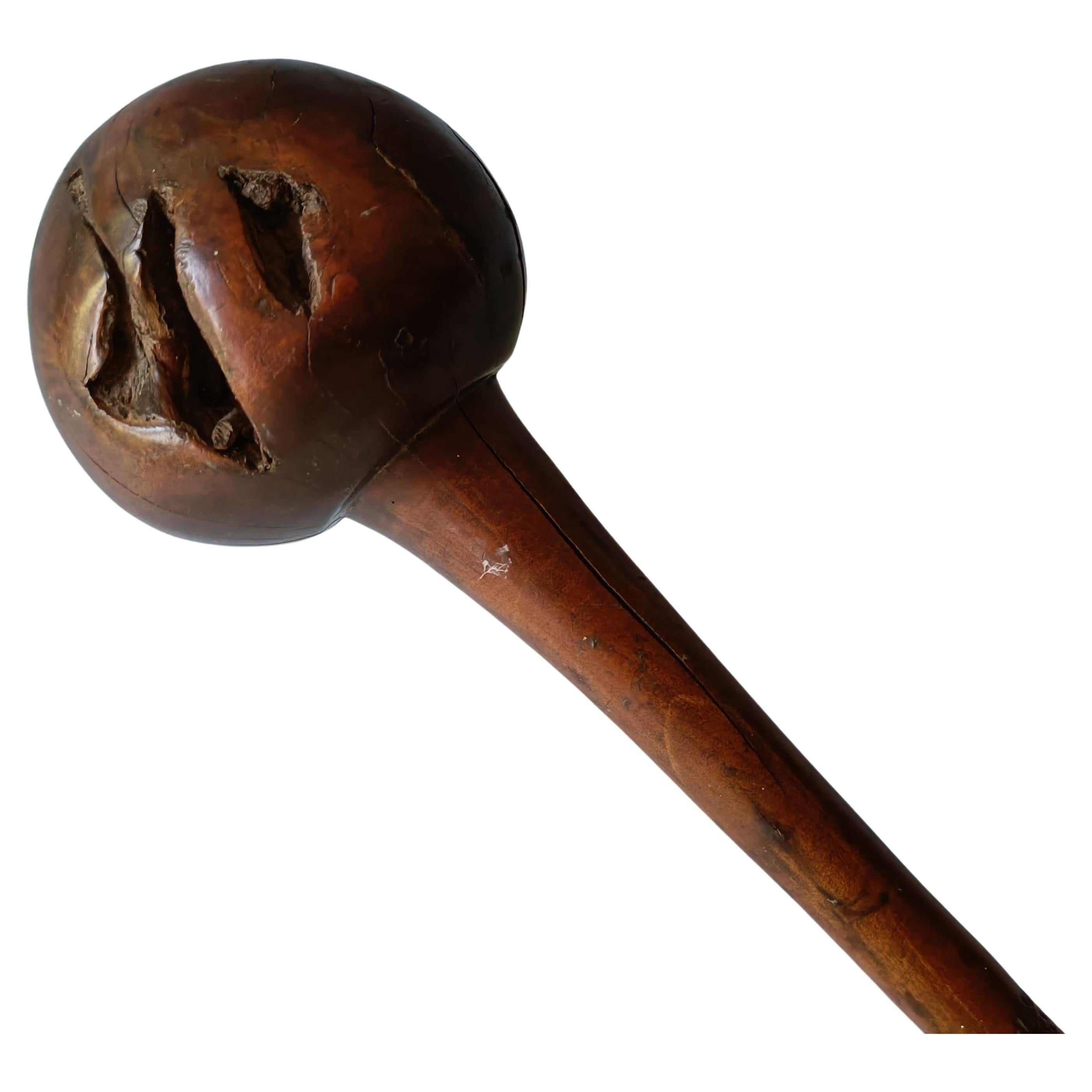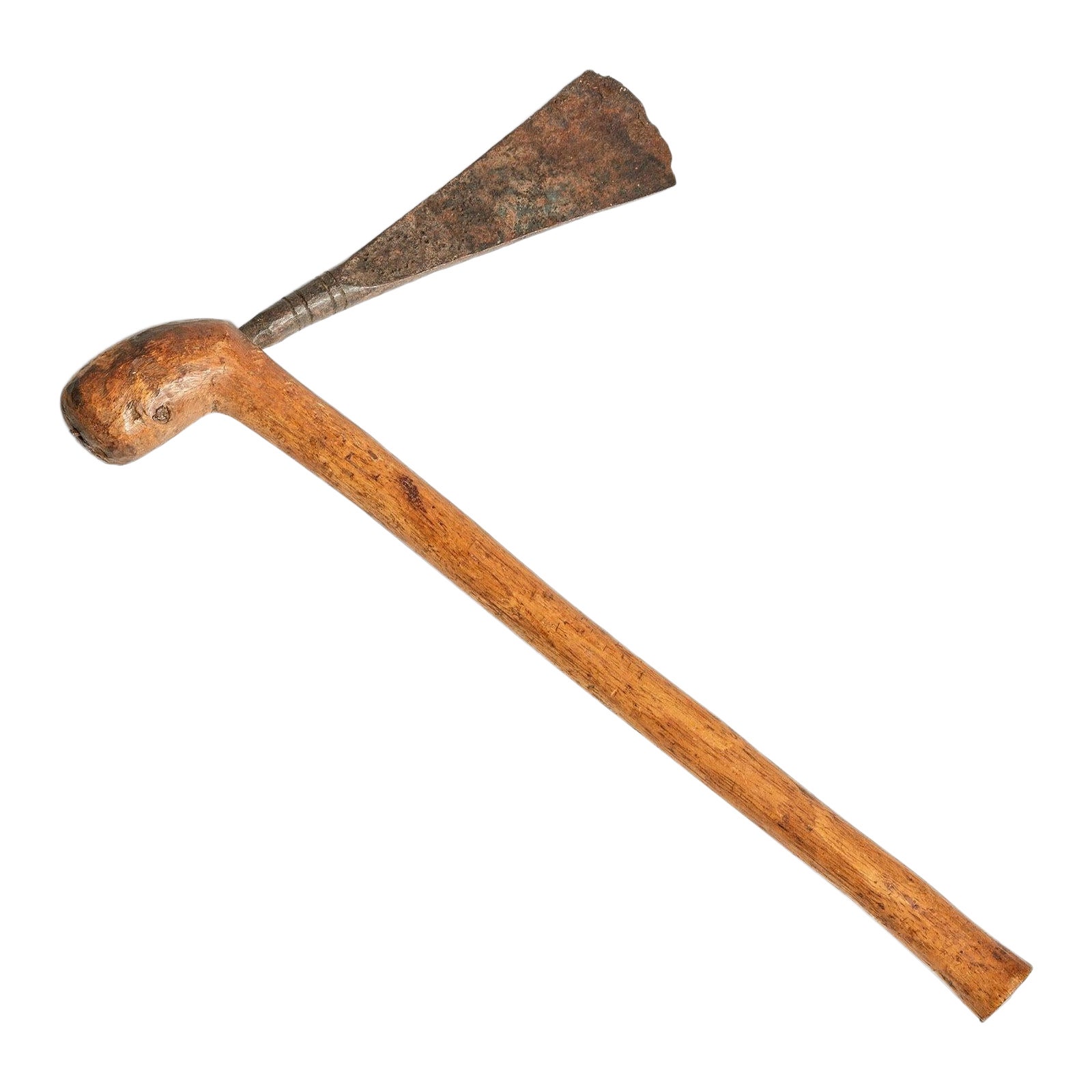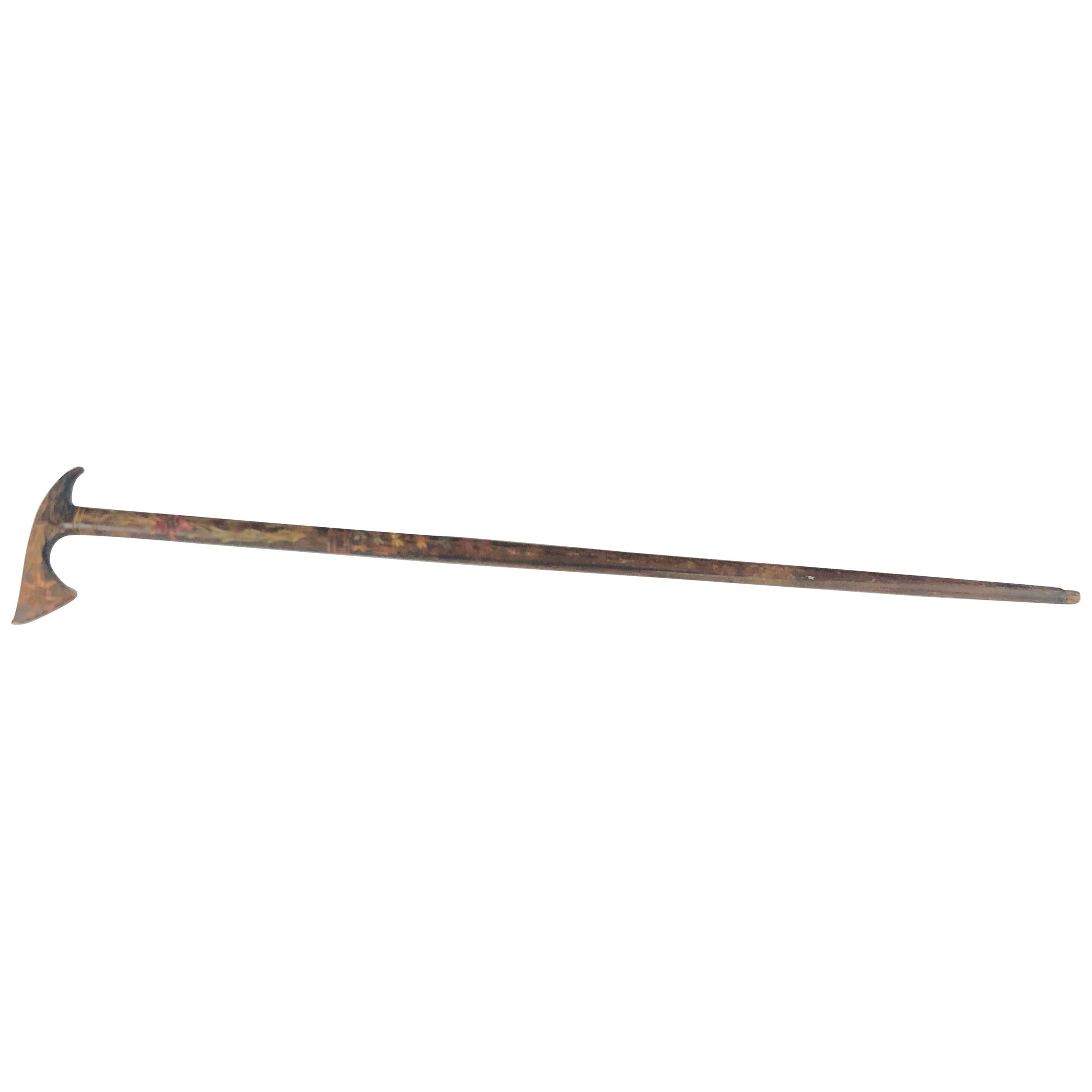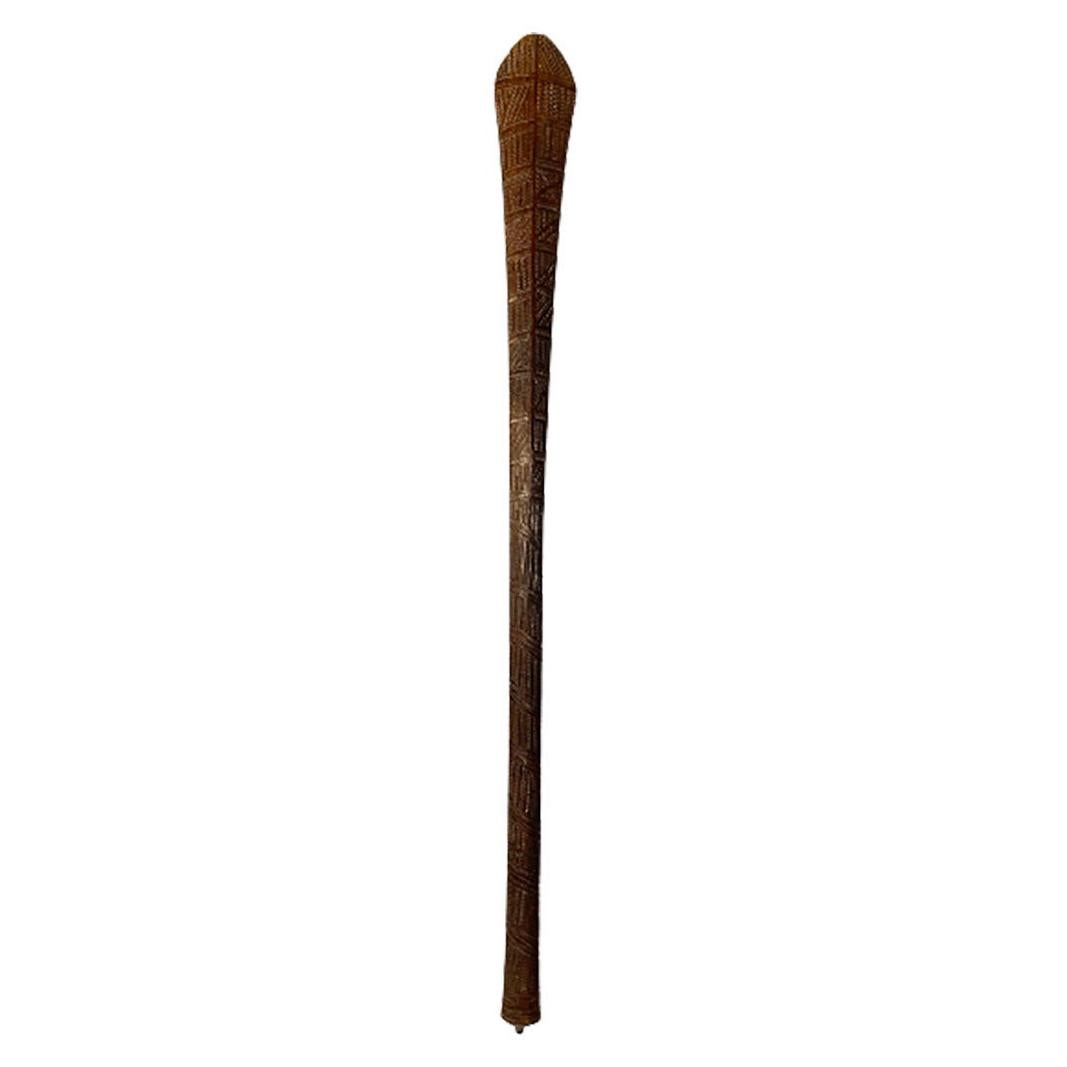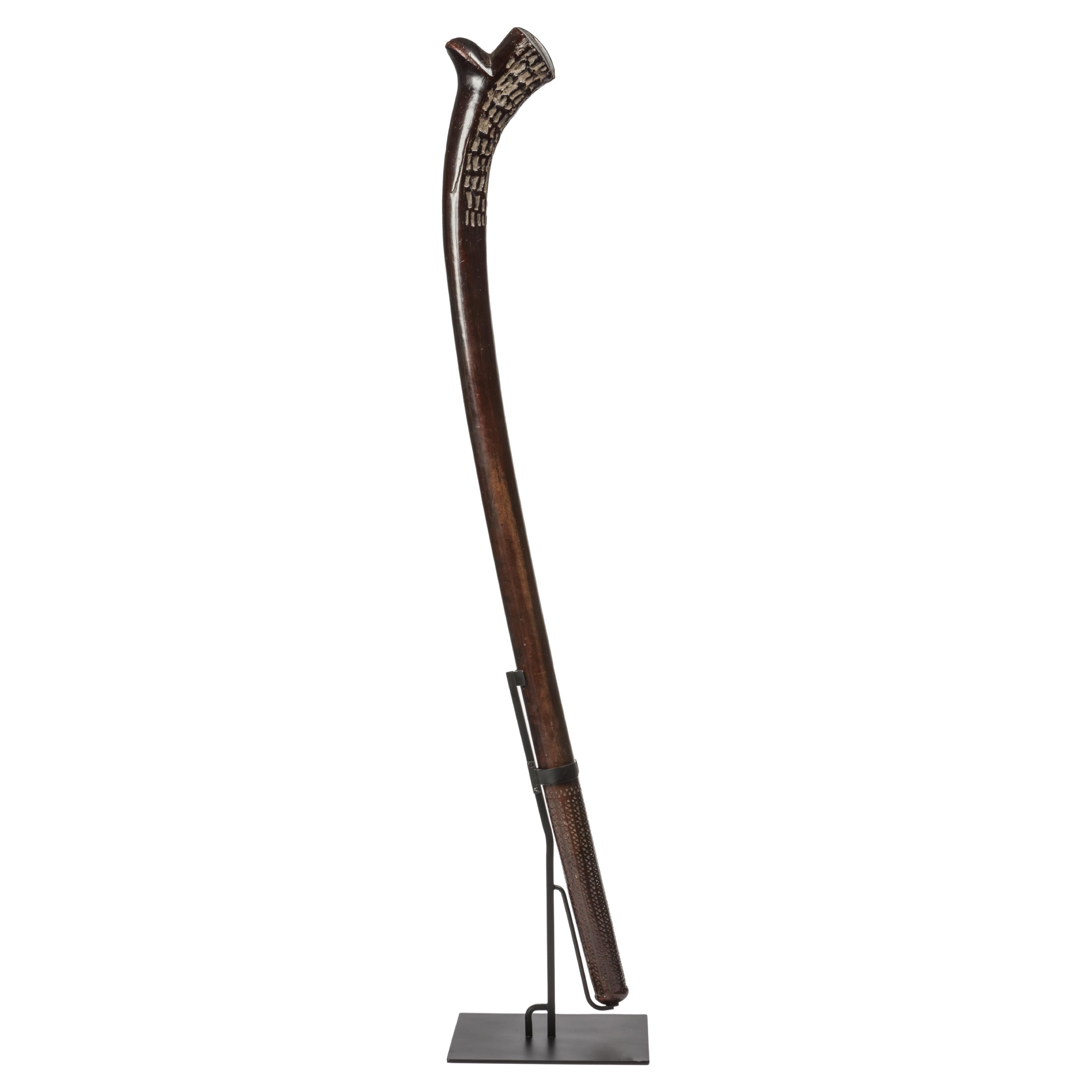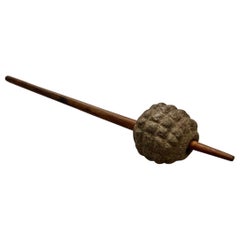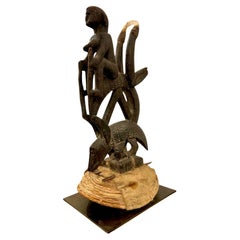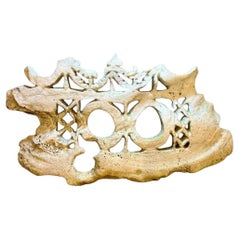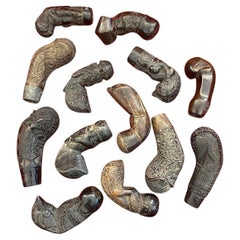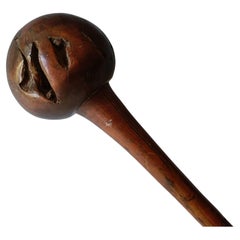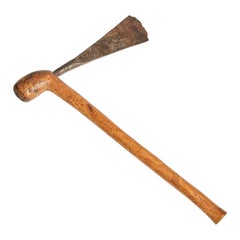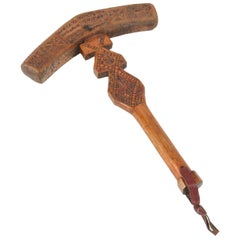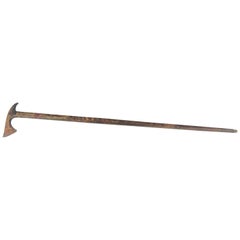Items Similar to Rare Kanak "kagu" Wooden Bird Beak Puzzle, New Caledonia, 19th Century
Video Loading
Want more images or videos?
Request additional images or videos from the seller
1 of 15
Rare Kanak "kagu" Wooden Bird Beak Puzzle, New Caledonia, 19th Century
$4,552.95
£3,388.74
€3,800
CA$6,236.40
A$6,936.24
CHF 3,621.89
MX$84,406.60
NOK 46,257.02
SEK 43,380.92
DKK 28,928.07
Shipping
Retrieving quote...The 1stDibs Promise:
Authenticity Guarantee,
Money-Back Guarantee,
24-Hour Cancellation
About the Item
Rare Kanak war club of the "Kagu" type (Bird's beak) in hardwood, from New Caledonia, Melanesia, 19th century.
This is an exceptional Kanak art collector's item due to its imposing size and its rare balance on this type of object.
This ancient combat tool, carved in a beautiful solid hardwood decorated with a magnificent dark brown and shiny patina, is distinguished by its long cylindrical handle which ends in a stylized bird's head, with an elongated beak, two raised eyes and a crest falling at the back of the neck.
The handle reflects the traditional style of Kanak clubs. Clubs are an integral part of the Kanak arsenal. Although several forms exist, the most widespread are divided mainly into two categories: "phallic" brain teasers and those in the shape of a "bird's beak" or turtle.
Their use for war and dances is omnipresent throughout New Caledonia. According to Maurice Leenhardt, these objects are used to express virility during war speeches, an essential aspect of the oral tradition. The different forms do not correspond to a specific use, but reflect regional styles, each socio-political group imprinting its identity on the objects it uses.
These clubs were brandished during the pilous, in particular for the declamation of genealogical speeches, symbolizing masculine virility and power. A drawing in Indian ink on tracing paper, made around 1954, attests to the objects collected before 1900 by the curator Bernier for the "New Caledonian Museum". This model of Kanak puzzle, called “phallic”, represents a formidable weapon used in close combat in New Caledonia.
- Dimensions:Height: 30.32 in (77 cm)Width: 13.78 in (35 cm)Depth: 3.15 in (8 cm)
- Materials and Techniques:
- Place of Origin:
- Period:
- Date of Manufacture:Circa 1850
- Condition:Wear consistent with age and use.
- Seller Location:NICE, FR
- Reference Number:1stDibs: LU9202241985012
About the Seller
5.0
Gold Seller
Premium sellers maintaining a 4.3+ rating and 24-hour response times
Established in 2003
1stDibs seller since 2023
28 sales on 1stDibs
Typical response time: 5 hours
- ShippingRetrieving quote...Shipping from: NICE, France
- Return Policy
Authenticity Guarantee
In the unlikely event there’s an issue with an item’s authenticity, contact us within 1 year for a full refund. DetailsMoney-Back Guarantee
If your item is not as described, is damaged in transit, or does not arrive, contact us within 7 days for a full refund. Details24-Hour Cancellation
You have a 24-hour grace period in which to reconsider your purchase, with no questions asked.Vetted Professional Sellers
Our world-class sellers must adhere to strict standards for service and quality, maintaining the integrity of our listings.Price-Match Guarantee
If you find that a seller listed the same item for a lower price elsewhere, we’ll match it.Trusted Global Delivery
Our best-in-class carrier network provides specialized shipping options worldwide, including custom delivery.More From This Seller
View All19th Century Kukukuku Club from Highlands Papua
Located in NICE, FR
This rare antique Kukukuku (pronounced "cookah-cookah") war club is from the remote highlands of Papua New Guinea. It features a head made of stone in the characteristic 'pineapple' ...
Category
Antique 19th Century Papua New Guinean Tribal Arms, Armor and Weapons
Materials
Stone
Ciwara Bambara headdress in carved wood and basketry, Mali, Early 20th century
Located in NICE, FR
A very pleasing Ciwara crest, singularly small and accompanied by its original headdress, depicting a stylized antelope leaning on a pangolin. The antelope is ridden by a woman, and white horsehair has been added to the tips of the horns. The piece is carefully sculpted, with notches decorating the bodies of the antelope and the pangolin.
Rattan, plant fiber, cowries, wood Very fine velvety mat patina, Circa 1950
An animal called Ciwara is said to have taught the Bambara how to cultivate the land, and during agrarian ceremonies, they recall the myth through the stylized representation of an antelope whose name ci wara...
Category
Early 20th Century Malian Tribal Tribal Art
Materials
Wood
Shell Plaque (Barava) from Solomon Islands, 19th Century
Located in NICE, FR
Objects crafted from the shell of the giant Tridacna clam, also known as the fossilized giant clam, held great value among numerous Melanesian peoples. The artistry of working with f...
Category
Antique 19th Century Solomon Islands Tribal Tribal Art
Materials
Shell
Collection of Kriss Handles, Java, Indonesia, Late 18th / Early 19th Century
Located in NICE, FR
A set of thirteen kriss handles originating from Java, Indonesia, dating from the late 18th to early 19th century.
Beautiful aged patina in dark or amber tones. Exquisite carving wo...
Category
Antique 1790s Indonesian Tribal Tribal Art
Materials
Wood
Dan Mask from Ivory Coast, Africa, 1950
Located in NICE, FR
This very elegant Dan mask is well-proportioned with a long protruding mouth from Ivory Coast, Africa. It dates back to the 1950s. The base is included in the price.
Dan masks have...
Category
Mid-20th Century Ivorian Tribal Masks
Materials
Wood
Bamana N'tomo mask, Mali, 20th century
Located in NICE, FR
Bamana N'tomo mask, Mali, 20th century
"Generally surmounted by three to eight horns forming a comb, the N'tomoface mask refers to a moment of compulsory education given to uncircumcised young boys in certain West African societies. The mask's discreet, even absent, mouth emphasizes the behavior expected of them in their future adult life after training: controlling and measuring their words, knowing how to keep quiet, preserving secrets and enduring pain in silence."
Excerpt from Masques du N'tomo, Marc Ladreit de Lacharrière Collection, Musée du Quai Branly Jacques Chirac, France.
The Bambara, or Bamana, live in central and southern Mali. Their name means “unbeliever” and was given to them by the Muslims. Animists, they believe in the existence of a creator god called Ngala, who maintains the order of the universe and coexists with another androgynous god called Faro, master of the Word, who gave all qualities to mankind and makes the fruits of the earth grow. Traditional Bamana art objects are closely linked to agrarian rites.
The Bamana dance these masks during initiation and circumcision ceremonies for young boys in the Ntomo society. The face, with its vertical outgrowths at the top, adopts geometric features beneath a rounded forehead, including an imposing busted nose, as the Bamana favor this organ in their statuary as it evokes sociability and clan cohesion. Indeed, during choreography, the dancer frequently touches the nose of the mask.
As teaching aids for candidates, masks from societies accessible to young boys and adults, such as the N'tomo, Korè and Ci wara...
Category
Vintage 1930s Malian Tribal Tribal Art
Materials
Wood
You May Also Like
Fiji Ula Club Polynesian war club Tribal Oceanic Antiques
Located in London, GB
Fiji Ula Club Polynesian war club Tribal Oceanic
A good antique Fiji Ula throwing club
With naturally occurring root fissures on the ball head
Good condition with minor age cra...
Category
Antique 19th Century Fijian Tribal Art
Materials
Hardwood
Primitive Tribal Axe from Africa
Located in Sagaponack, NY
An expressive hand crafted primitive axe having an elongated wrought blade attached to a finely carved and shaped hardwood handle.
Category
Antique 19th Century African More Asian Art, Objects and Furniture
Materials
Wood
Moroccan Tribal Berber Wooden Sugar Hammer
By Berber Tribes of Morocco
Located in North Hollywood, CA
Moroccan tribal Berber wooden sugar hammer.
Handcrafted by the Berber women of Morocco, hand-carved wood with tribal design, this folk art instrument is a...
Category
Early 20th Century Moroccan Folk Art Tribal Art
Materials
Wood
1900s Antique Hand Carved Wooden Cane
Located in Plainview, NY
An early 20th century hand carved wood men's cane. The cane features beautiful hand carving of flowers painted in multiple colors. The name of what it seems to be the original owner ...
Category
Early 20th Century American Folk Art Antiquities
Materials
Wood
$520 Sale Price
20% Off
Tonga Pakipaki War Club, Polynesia, 18th Century
Located in Delft, NL
A Tonga Pakipaki war club, Polynesia, 18th century
An exceptional ironwood war club originating from Tonga, Polynesia. 18th century and hand carved with complex geometric patterns running the length of the shaft.
4 human and 1 botanical glyphs and a extra carving, see details in picture 2
The Tongan war club...
Category
Antique 18th Century Polynesian Tribal Art
Materials
Wood
18th Century Polynesian Ironwood Gata Waka or War Club from Fiji
Located in Amsterdam, NL
A Polynesian ironwood Gata waka or war club
Fiji, probably 18th century or earlier
Measures: Height. 97 cm
Including museum-quality powder-coated stand.
Provenance:
Private collection, France
Polynesian culture is traditionally a culture of power and prestige, and there was a fine line between battle and ceremony. Warrior people par excellence, the Fijians had at their disposal a large panoply of weapons, each for a specific use.
The elegant Gata are called gun-sticks by Europeans due to the recognizable form. However, they are designed after a snake, gata in Fijian language. The Ula throwing clubs...
Category
Antique 18th Century Fijian Tribal Art
Materials
Hardwood
More Ways To Browse
Wood Weapons
Antique Drawing Tools
Antique Long Handled Tools
Wood War Club
Ancient Weapon
Antique Wood Puzzle
Brain Model
Polynesian Art
Large Tribal Necklace
Papua New Guinea Figure
Tribal Sword
Congo Statue
Papua New Guinea Carving
Tribal Bamileke
African Currency Bracelet
Antique Adze
Polychrome Face Mask
Yoruba Crown
